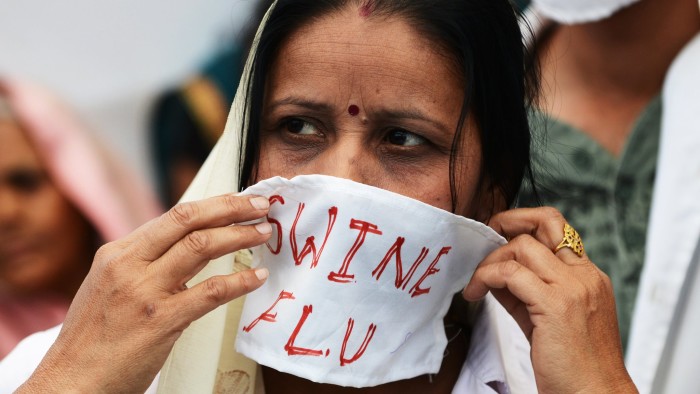Race for universal flu vaccine gathers pace

Roula Khalaf, Editor of the FT, selects her favourite stories in this weekly newsletter.
Every year millions of people head to their doctors’ surgeries to roll up their sleeves and receive their annual flu jab.
In anticipation, the World Health Organisation convenes meetings each February and September to recommend which strains of influenza to include in seasonal vaccines, based on the viruses circulating around the world at the time. Candidate vaccines are then formulated and, over the next six to eight months, sufficient stocks are built up by manufacturers for the vaccination campaigns that begin in the autumn.
Usually, the resulting vaccine provides reasonable protection against infection over the following winter, although in some years — 2014-15, for example — the vaccine has missed its target, either because the surveillance was misleading or the virus changed its character unusually quickly.
All this is necessary because the influenza virus is extraordinarily variable. One of the highest priorities in medical virology is to develop a “universal vaccine” that would protect against any strain of the disease. A breakthrough like that would cut out the expensive and time-consuming process of preparing vaccines against seasonal flu, which kills an estimated 250,000-500,000 people a year. It would also be a lifesaver should a virulent new strain of pandemic flu emerge, perhaps through the mutation of a porcine or avian flu virus.
Flu pandemics — when an infectious disease spreads over a wide geographic area or even worldwide — struck three times during the 20th century and once in the 21st. The most serious of these, the Spanish flu of 1918-19, infected 500m people and left more than 50m dead. Virologists say another severe pandemic is inevitable.
Both academic and corporate labs are now working on versions of universal flu vaccines, though their efforts are at early stages of development. “What all universal flu vaccine candidates have in common is that, although some of the parts of the flu virus change rapidly, there are actually other parts of the virus that are relatively stable, year on year,” says Richard Antrobus, a flu researcher at Oxford university. “[Those parts] are also relatively the same between different strains of flu. Universal vaccines target the immune system [towards] these parts of the virus.”
The trouble with this approach in practice is that the stable parts tend to lie deep within the virus, where they are hard to reach, while the variable ones are on the surface. But there are ways to get inside the virus, for example through immune cells (T-cells) that recognise internal proteins.
Another approach is to attack a vital protein called haemagglutinin, or HA, that enables the flu virus to bind to the cell it is infecting. HA has a very variable “head region”, which sticks out of the viral surface, and a less accessible but stable “stem region”. Two teams, one at the US National Institutes of Health and the other a collaboration between the Scripps Research Institute in California and Johnson & Johnson, have reported promising results with animal tests of an experimental vaccine based on different approaches to the HA stem.
“If the body can make an immune response against the HA stem, it is difficult for the virus to escape,” says Ian Wilson, a Scripps biology professor. “We are moving in the right direction for a universal influenza vaccine. This was the proof of principle.”
But a truly universal flu vaccine is not going to spring suddenly on to the market, says Dr Antrobus. “It is more likely that we will see a series of vaccines being released . . . which will provide more protection against a broader range of influenza strains.”
John Shiver, head of R&D at Sanofi Pasteur, the French vaccine company, agrees. “While a truly universal vaccine is the ultimate goal, we believe that a broader spectrum vaccine could be available first to replace the current seasonal flu vaccine,” he says.
Sanofi Pasteur published a research paper in March in collaboration with the University of Georgia. The team developed an HA “computationally optimised broadly reactive antigen” or “Cobra”, which is active against many different strains of H1N1 influenza, one of the most dangerous flu types, in animal tests.
“This experimental vaccine is generated from the sequences of many flu viruses and is designed to help protect against many strains over several years,” says Tim Alefantis, Sanofi Pasteur project leader.
Although most efforts have been directed at the “antigen” — the part of the vaccine consisting of proteins from the flu virus that stimulate an immune response in the recipient — some researchers are also looking at “adjuvants” — added chemicals that enhance a vaccine’s effectiveness. Most vaccines use alum, a simple inorganic compound, but two university teams have recently reported good results with more complex organic adjuvants.
Australian researchers at the University of Melbourne published evidence last October that a synthetic lipoprotein, a fatty molecule that mimics a component of pathogens’ outer membrane, boosted the response of animals to flu vaccine. And, in January, scientists at the University of Missouri found that added lactoferrin, a protein in breast milk that strengthens a baby’s ability to fight infection, could increase the effectiveness of vaccination in infants.
“The biggest advantage is that this approach does not rely on getting a match between the strains used in the vaccine and the circulating virus,” says Brendon Chua of the University of Melbourne. “You can still get some protective effect at the population level.”

Comments